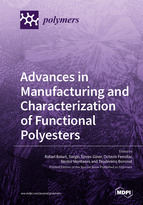Advances in Manufacturing and Characterization of Functional Polyesters
A special issue of Polymers (ISSN 2073-4360). This special issue belongs to the section "Polymer Applications".
Deadline for manuscript submissions: closed (30 September 2020) | Viewed by 52830
Special Issue Editors
Interests: aliphatic polyesters; blends; compatibilization; advanced characterization; functional additives; unsaturated polyester resins; composites
Special Issues, Collections and Topics in MDPI journals
Interests: bio-based and biodegradable polymers; green composites; polymerization of biopolymers; processing of bioplastics; nanofibers obtained by electrospinning; sustainable polymer technologies for food preservation; controlled release of active compounds in plastic formulations; biopolymers for food packaging; bioeconomy; circular economy
Special Issues, Collections and Topics in MDPI journals
Interests: manufacturing; polymer analysis; thermal characterization; biopolyesters; biodegradation; film processing; nanoparticle functionalization; manufacturing of composites; thermosetting resins
Special Issues, Collections and Topics in MDPI journals
Interests: biopolymer composites; polymer characterization; green compatibilizers; chain extenders from renewable resources; circular economy; polymers and composites with functional properties; natural fibers composites; recycling
Special Issues, Collections and Topics in MDPI journals
Interests: polymer manufacturing; 3D printing; polyesters; medical applications; process modeling; computer-aided engineering (CAE); computer-aided manufacturing (CAM); polymer stents; fixation plates
Special Issues, Collections and Topics in MDPI journals
Special Issue Information
Dear Colleagues,
In the last years, we have assisted to a remarkable grow on the use of polyesters. Although some aromatic polyesters such as PET of PBT are well known, in the recent years, great interest on aliphatic polyesters has been detected. This group includes both petroleum-derived polyesters such as poly(e-caprolactone)-PCL, poly(butylene succinate)-PBS, poly(glycolic acid)-PGA among others, and polyesters from renewable resources such as poly(lactic acid)-PLA and the promising poly(hydroxyalkanoates)-PHAs. These polymers offer a positive environmental efficiency and can be functionalized by synthesis, copolymerization, additives (at micro and nano-scale), surface modification and so on to tailor the desired properties in terms of mechanical, chemical, thermal, barrier properties, biodegradation, biocompatibility. This can widen the potential use of these materials in industrial sectors such as packaging, textiles and apparel, automotive, construction and building and other specialized sectors such as medicine (medical devices, tissue engineering, resorbable components, controlled drug release), electrical and electronics, shape-memory devices, among others.
This special issue aims to compile original and cutting-edge research works in the field of synthesis, characterization, manufacturing and applications of functional polyesters.
Prof. Dr. Rafael Antonio Balart Gimeno
Prof. Dr. Sergio Torres-Giner
Prof. Dr. Octavio Ángel Fenollar Gimeno
Prof. Dr. Nestor Montañés Muñoz
Prof. Dr. Teodomiro Boronat Vitoria
Guest Editors
Manuscript Submission Information
Manuscripts should be submitted online at www.mdpi.com by registering and logging in to this website. Once you are registered, click here to go to the submission form. Manuscripts can be submitted until the deadline. All submissions that pass pre-check are peer-reviewed. Accepted papers will be published continuously in the journal (as soon as accepted) and will be listed together on the special issue website. Research articles, review articles as well as short communications are invited. For planned papers, a title and short abstract (about 100 words) can be sent to the Editorial Office for announcement on this website.
Submitted manuscripts should not have been published previously, nor be under consideration for publication elsewhere (except conference proceedings papers). All manuscripts are thoroughly refereed through a single-blind peer-review process. A guide for authors and other relevant information for submission of manuscripts is available on the Instructions for Authors page. Polymers is an international peer-reviewed open access semimonthly journal published by MDPI.
Please visit the Instructions for Authors page before submitting a manuscript. The Article Processing Charge (APC) for publication in this open access journal is 2700 CHF (Swiss Francs). Submitted papers should be well formatted and use good English. Authors may use MDPI's English editing service prior to publication or during author revisions.
Keywords
- Polyesters
- functional
- blends
- additives
- compatibilizers
- synthesis
- biodegradation
- copolymerization
- manufacturing
- characterization.
Related Special Issue
- Polyesters in Polymers (56 articles)











